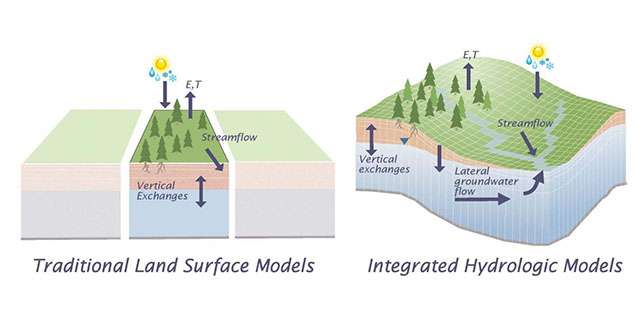Groundwater flow is key for modeling the global water cycle

Plants are one of the largest water users on land and, through transpiration, they move more water into the atmosphere than streams or rivers move across the landscape. Unlike stream flow, which can be easily observed, measuring or simulating the amount of water plants transmit to the atmosphere is a significant challenge.
Now, using the U.S. Department of Energy's advanced computing capabilities, scientists have modeled plant transpiration from groundwater to the atmosphere. In doing so, they have discovered that lateral groundwater flow, which has not been included in previous modeling studies, may be the missing link to predicting how important plant water use is to the global water cycle.
Managing water resources at regional scales requires understanding how much water the vegetation in that region uses. The relative importance of plant transpiration is one of the largest uncertainties in balancing regional and global water cycling. Improving the regional and global simulations of plant transpiration will enable scientists to better predict how the water system will respond to future Earth system changes. The new insights will also let scientists predict and understand how much freshwater is globally available.
Using integrated hydrologic simulations that couple vegetation and land energy processes with surface and subsurface hydrology, the researchers studied the relative importance of transpiration as a fraction of all the water moving from the land surface to the atmosphere (commonly referred to as transpiration partitioning) at the continental scale. They found that both the total flux of water and transpiration partitioning are connected to water table depth. Because of this connection, including groundwater flow in the model increases transpiration partitioning from 47±13% to 62±12%. This finding suggests that groundwater flow, which is generally simplified or excluded from other continental-scale simulations, may provide a missing link to reconciling observations and global models of terrestrial water fluxes.
More information: R. M. Maxwell et al. Connections between groundwater flow and transpiration partitioning, Science (2016). DOI: 10.1126/science.aaf7891
Journal information: Science
Provided by US Department of Energy


















